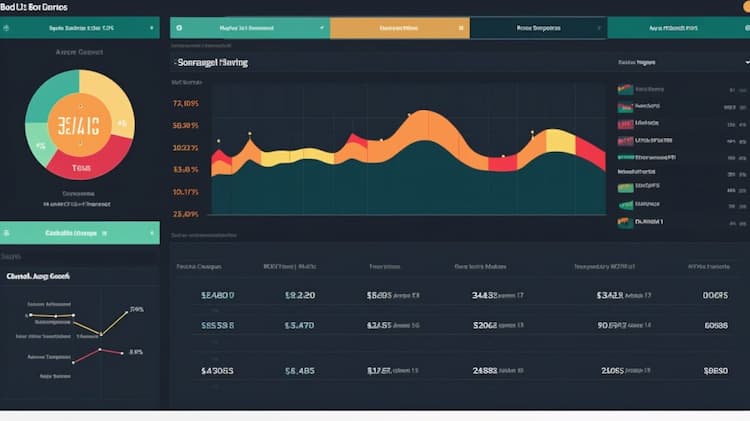
How does the JHEM ETF work?
The JHEM ETF is a specialized investment fund that focuses on a specific sector. This exchange-traded fund offers investors exposure to a range of companies in this sector.
The DFSD Short-Duration Fixed Income ETF is managed by a trusted issuer known for its expertise in fixed income investments. With a focus on achieving its investment objective through exposure to a diversified portfolio of U.S. and foreign corporate debt securities, including those issued or guaranteed by governments and agencies, the issuer aims to provide investors with a reliable and consistent source of income. The ETF emphasizes investments in high-quality, investment-grade fixed income securities while actively managing its portfolio to navigate changing market conditions and potential credit risks, ensuring it aligns with the goals of income-focused investors.
The DFSD Dividend ETF, focused on short-duration fixed income securities, primarily invests in a diversified portfolio of U.S. and foreign corporate debt securities with an investment-grade rating. Additionally, it may hold obligations issued or guaranteed by governments and their agencies, mortgage-backed securities, and other fixed-income instruments. The fund's policy dictates that at least 80% of its net assets are invested in investment-grade fixed income securities, which may include lower-rated bonds when deemed beneficial by the advisor. The ETF aims to maintain a weighted average duration close to its benchmark, the ICE BofA 1-5 Year US Corporate & Government Index, with an active management strategy. Dividend distribution may occur periodically, and investors should consider the fund's credit quality and interest rate sensitivity when evaluating its potential for dividend returns.
Tracking the Short-Duration Fixed Income ETF involves investing in a diversified portfolio of U.S. and foreign corporate debt securities, primarily with investment-grade ratings. This ETF may also hold obligations issued or guaranteed by governments, agencies, and instrumentalities, as well as mortgage-backed securities, bank obligations, commercial paper, and more. While the ETF actively manages its portfolio, it generally maintains a weighted average duration close to its benchmark, the ICE BofA 1-5 Year US Corporate & Government Index. Additionally, it may employ various hedging strategies, including foreign currency forward contracts and credit default swaps, to manage currency and credit exposure. Invest in DFSD for a dynamic approach to short-duration fixed income investments.
The correlation aspect of the Short-Duration Fixed Income ETF (DFSD) is primarily associated with its exposure to a diversified portfolio of U.S. and foreign corporate debt securities with an investment-grade rating. DFSD's correlation is expected to be influenced by the performance of these fixed income securities, making it sensitive to interest rate fluctuations and credit risk. Investors interested in DFSD's correlation can utilize ETF Insider's web app to explore its relationships with various fixed income benchmarks and market factors, providing valuable insights for constructing a well-diversified and risk-managed investment portfolio. Additionally, the app's visualization tool offers a simple way to analyze the overlap between DFSD and other ETFs, aiding in the identification of potential diversification opportunities.
The DFSD SECTOR ETF focuses on short-duration fixed income securities, aiming to provide investors exposure to a diversified portfolio of U.S. and foreign corporate debt securities with investment-grade ratings. Additionally, it may invest in government obligations, mortgage-backed securities, bank obligations, and other fixed-income instruments. The fund typically maintains a weighted average duration close to its benchmark, the ICE BofA 1-5 Year US Corporate & Government Index, in an effort to manage interest rate sensitivity. While actively managed, it does not seek to replicate the performance of a specific index, potentially leading to a higher portfolio turnover compared to passive index funds.
The exposure characteristic of the Short-Duration Fixed Income ETF (DFSD) is centered around its investment in a broad portfolio of U.S. and foreign corporate debt securities with an investment grade rating. This ETF provides investors with exposure to high-quality fixed income assets, including government obligations, mortgage-backed securities, and corporate debt, with an emphasis on investment-grade quality. With a focus on securities that mature within five years and the ability to hedge foreign currency exposure, DFSD offers a well-diversified and risk-managed approach to fixed income investing.

ETF Insider is a data-driven portfolio analytics and optimization platform that introduces a more efficient and practical way to visualize, analyze and optimize portfolios.
Rather than focusing on the surface-level attributes of ETFs and Mutual Funds, ETF Insider goes deeper by examining the underlying holdings of exchange traded products.
By organizing and structuring that data, investors can easily navigate within their overlapping layers.
This innovative perspective combined with modern data visualization and modeling tools, provides an entirely new approach to portfolio optimization that can quickly expose both portfolio inefficiencies and opportunities.

The JHEM ETF is a specialized investment fund that focuses on a specific sector. This exchange-traded fund offers investors exposure to a range of companies in this sector.

Whether you're interested in U.S. large-cap stocks or Eurozone equities with currency hedging, these CSPX and SSAC ETFs offer unique opportunities.

The DFSD ETF is a specialized investment fund that focuses on a specific sector. This exchange-traded fund offers investors exposure to a range of companies in this sector.
ETF Insider is a novel portfolio optimization tool that uses the power of data visualization to gain insight into portfolio compositions, concentration risks, portfolio efficiency and more. Complex financial data can be transformed into visually appealing and easily digestible graphs and charts, allowing investors to quickly identify trends and make well-informed investment decisions. Not only does this save time, but it also increases the accuracy and effectiveness of portfolio management.